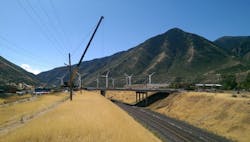Utah DOT increases safety on Rte. 6 Bridge project
The Rte. 6 Bridge Deck Replacement Project Team took a hard look at a range of traffic-mitigation scenarios from full closure to a one-lane road with alternating traffic. After assessing cost of delay up to $80,000 per day, an addition of up to 60 minutes of travel time and potential for 3- to 4-mile queues in canyon conditions, the team set a goal of 20 minutes or less of travel delay to optimize mobility for travelers on Rte. 6 using the one-lane road across the bridge with alternating traffic. Traffic modeling of this configuration showed that a 10-15% reduction in traffic would help meet the goal.
Because the canyon approach to this bridge has limited sight distance due to curves, the project team also set a goal for 1 mile or less of queuing and other traffic-calming measures to support Utah DOT’s goal of zero fatalities. The team also implemented a 24-hour weight restriction across the bridge to minimize structural deflection during concrete cure time.
To minimize delays and maintain safety, the team:
- Accelerated construction from 17 to 13 days, which was achieved by the contractor’s hour-by-hour construction plan and 24-hour work schedule, and a collaborative effort between Utah DOT, contractors and consultants;
- Planned detour routes for truck traffic that avoided heavy loads traveling over the bridge to minimize deflection during concrete cure times;
- Provided public information to the trucking industry and other travelers that helped establish driver expectations and reduce traffic congestion through the project work zone;
- Adjusted signal timing on-site to maximize “green” time for peak traffic directions; and
- Installed temporary cameras to monitor the queuing and traffic flow. The on-site team could then quickly make adjustments.
The project team also used a proprietary product made by Plastic Safety Systems called RoadQuake. They are portable transverse rumble strips that alert distracted drivers with auditory and vibratory sensation that they are entering a caution zone. They were owned and provided to the project by the Utah DOT but deployed and maintained by AAA Barricade.
The project team placed them far outside the project limits as the first element of traffic control. Due to canyon conditions, traffic could potentially come out of a steep winding canyon at 60 mph to the back of stopped cars.
Because drivers had been alerted by the temporary rumble strips, there were no rear-end accidents, no skidding cars and no close calls. Any extraneous or secondary accidents would have driven delay through the roof, as it did with an accident up the canyon during construction which delayed drivers by roughly 90 minutes. Many drivers did not notice the VMS or static signs approaching the construction zone, but none were able to bypass the warning message provided by the rumble strips.
Traffic counts were taken during the one-lane configuration to compare it with traffic counts prior to construction. Through the team’s public communication efforts and aggressive traffic-mitigation approach, the Rte. 6 Bridge Deck Replacement Project Team realized a 15-20% reduction in traffic, which helped meet the goal of 20 minutes or less in additional travel time. In addition to a great diversion of passenger vehicles, the project team experienced a 25-30% reduction in heavy trucks. As further evidence of effectiveness, hotline calls during the one-lane configuration were focused on questions related to trip planning instead of complaints, which speaks to the success of the communication effort to notify travelers of possible delays.
The contractor’s commitment to complete the work early helped Utah DOT successfully optimize mobility during construction. Likewise, collaboration and coordination within Utah DOT, and with contractors and consultants, resulted in minimized impact to the traveling public. A solid work plan with contractor incentives, a clear communication plan for team coordination and public messaging and leveraging technical tools like signal timing and the rumble strips helped the Rte. 6 Bridge Deck Replacement Team optimize mobility and achieve the Utah DOT’s safety goal of zero fatalities.
Many thanks to Eileen Barron, Utah DOT Region Three Communications Manager, who wrote the project report and graciously allowed us to excerpt material from it.
